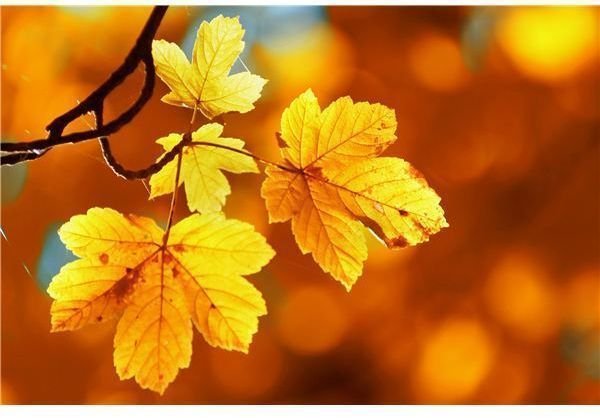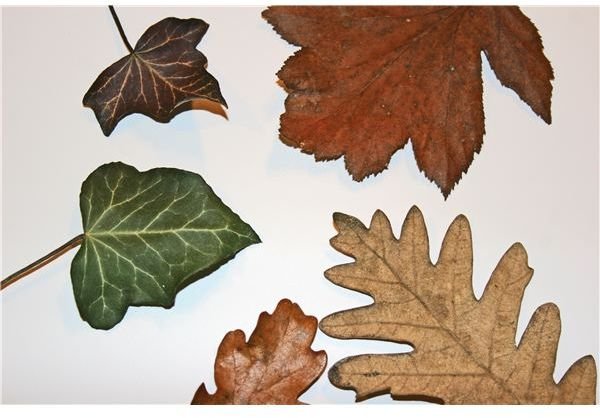Five Creative Kindergarten Leaf Art Projects
Leafy Art Fun–Preserving Your Foliage
Nature and its products are an important theme for kindergarten. Leaf art projects and activities, while traditionally fall ideas in the classroom, can be used year-round to help students develop an appreciation for the beauty around them.
Combine science with art by first preserving the leaves your students will be using in their projects. This helps the foliage maintain its color and pliability so that the leaves don’t get brittle and ugly.
For this, you will need:
- 1/2 cup glycerin
- 1 cup warm water
- Flat pan or container
Mix the glycerin and the water; pour it into the pan. Add the leaves. For young, green leaves, leave them in the solution for one to two days. For mature leaves or those that have changed to their fall colors, leave them up to three weeks.
Leafy Feathered Birds
Use fall-colored leaves as the tail feathers for turkeys. Duplicate a turkey’s head and body on cardstock. After students cut out the shapes, they glue their leaves to the back to make the tail spread.
Smaller leaves can be used to make the wings of other birds throughout the year. Students can glue the leaves to a template, both as wings and as tail feathers. Another option is to have the children cut a slit in the center of the body shape and to insert the leaf’s stem through the slit, gluing it to the other side, to make it look like the bird is flying.
Leaf People
For this project, let students combine leaves in different sizes to create the body, head and limbs of people. They may also layer the leaves to make clothes, hats, shoes and other apparel for their leafy friends.

Extend this idea by allowing students to make entire foliage families, including leafy pets. They may also use the larger leaves to design a house for their clan.
“Stained Glass” Leaves
For students in more temperate regions of the country, fall foliage may not look much different from that of the spring and summer, other than the size of the leaves. Help those children experience the different colors of leaves with faux stained glass leaf shapes.
For this project, you will need:
- Waxed paper
- Crayons
- Scissors or pencil sharpeners
- Iron
- Leaf templates
Students begin by folding and then reopening a sheet of waxed paper. On one half of the paper, they shave crayons in different colors, filling the space with a single layer of shavings.
Next, they carefully fold the top of the waxed paper over the shavings. Make sure each paper is named, before the children enjoy a break time. Well away from the children, you can then melt the shavings and seal the paper by ironing it. Be sure to use a dry setting on the iron, and make sure it is out of a child’s reach at all times no matter if it is off or on.
When the “stained glass” has cooled, students can then trace the leaf shapes onto the waxed paper and cut out their leaves. These can be framed with construction paper leaf outlines, or left just as they are. Hang them on the windows so the sun shines through the colors.
Leaf Soaps
With the melt-and-pour technique of soap making, you have several options for incorporating the leaf art theme.
For these projects, you will need:
- Melt-and-pour soap base (available at most craft stores)
- Glass measuring cup with a spout
- Microwave
- Soap color and fragrances, as desired
- Soap additives, as desired (glitter, citrus peel, etc.)
- Soap molds
- Mold release spray (Cooking sprays will work nicely.)
For the simplest project, allow each student to select a color, a fragrance and another additive to mix with the melted soap base. With your help, the students then pour the mixture into leaf-shaped soap, candy, or candle molds that have been prepared with release spray. When the soap cools and hardens, it is ready for some clean fun.
For a more complex soap project, allow students to fill a square, round, or rectangular mold with leaf shapes made from plastic, clay, or more soap. When they are satisfied with their designs, help them carefully pour the melted soap base over the objects to create embedded soaps.
These kindergarten leaf art projects are just the beginning of the fun you and your students can have when you include natural objects in your craft supplies.
Resources
Preserving Flowers for Year-Round, by Clifford Collier Jr., on the website of West Virginia University.
Basic Melt and Pour Technique, from TeachSoap.com
Photos courtesy of PhotoExpress.com
